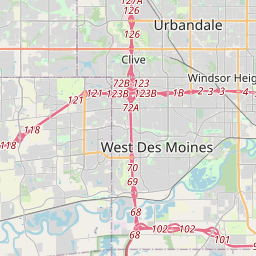Historic Des Moines / Noted Des Moines Residents
Historical marker location:
Waukee, Iowa
( Marker can be reached from Interstate 80 at milepost 119,, 1.9 miles east of Ute Avenue (County Road R22), on the right when traveling east.)
Marker installed: 1977







© OpenStreetMap contributors
Loading...
Searching for other points of interest within 3 miles of this location.In the early 1900s, the town of Villisca, Iowa was the site of a gruesome murder that remains unsolved to this day. On June 10, 1912, eight people were bludgeoned to death with an axe in their home. The crime is known as the Villisca Axe Murders and has been the subject of numerous books, films, and TV shows.
About Dallas County
Dallas County Timeline
Dallas County, located in the state of Iowa, has a rich and diverse history dating back thousands of years. The area was originally inhabited by Native American tribes, such as the Ioway, Sioux, and Sac and Fox, who relied on the land's abundant natural resources for sustenance and survival. European settlers began arriving in the mid-1800s, lured by the promise of fertile soils and opportunities for farming.
The establishment of Dallas County officially took place in 1846, shortly after Iowa became a state. The county was named after George Mifflin Dallas, the Vice President of the United States at the time. The first county seat was initially located in Adel, a small town situated along the North Raccoon River. However, after a contentious battle with the nearby town of Waukee, Adel retained its status as the county seat.
During its early years, Dallas County experienced rapid growth and development. Agriculture played a vital role in the county's economy, with crops like corn, soybeans, and livestock production becoming primary sources of income for the residents. The arrival of the railroad in the late 19th century further facilitated trade and transportation, boosting the county's prosperity.
In the 20th century, Dallas County continued to evolve and adapt to changing times. The construction of Interstate 80 in the 1960s brought increased accessibility, connecting the county to larger cities and markets. As a result, suburbanization became more prevalent, with many people choosing to settle in Dallas County and commute to nearby urban centers for work.
Today, Dallas County is known for its thriving economy, excellent schools, and quality of life. The county continues to experience significant population growth and development, attracting new businesses and residents. While agriculture remains an important industry, the county has also diversified its economy, with sectors like technology, healthcare, and manufacturing making significant contributions. Dallas County's history serves as a strong foundation for its present and future success.
The establishment of Dallas County officially took place in 1846, shortly after Iowa became a state. The county was named after George Mifflin Dallas, the Vice President of the United States at the time. The first county seat was initially located in Adel, a small town situated along the North Raccoon River. However, after a contentious battle with the nearby town of Waukee, Adel retained its status as the county seat.
During its early years, Dallas County experienced rapid growth and development. Agriculture played a vital role in the county's economy, with crops like corn, soybeans, and livestock production becoming primary sources of income for the residents. The arrival of the railroad in the late 19th century further facilitated trade and transportation, boosting the county's prosperity.
In the 20th century, Dallas County continued to evolve and adapt to changing times. The construction of Interstate 80 in the 1960s brought increased accessibility, connecting the county to larger cities and markets. As a result, suburbanization became more prevalent, with many people choosing to settle in Dallas County and commute to nearby urban centers for work.
Today, Dallas County is known for its thriving economy, excellent schools, and quality of life. The county continues to experience significant population growth and development, attracting new businesses and residents. While agriculture remains an important industry, the county has also diversified its economy, with sectors like technology, healthcare, and manufacturing making significant contributions. Dallas County's history serves as a strong foundation for its present and future success.
Dallas County Timeline
This timeline provides a condensed summary of the historical journey of Dallas County, Iowa.
- 1846: Dallas County is established as a county in the state of Iowa.
- 1855: The city of Adel is chosen as the county seat.
- 1860s: The arrival of the railroad leads to growth and development in Dallas County.
- 1868: A courthouse is built in Adel to replace the previous one that was destroyed by fire.
- 1880s: Agriculture becomes a major industry in the county, with the production of corn and hogs.
- 1910: The Des Moines Water Company is organized, bringing a reliable water supply to the county.
- 1930s: The construction of Highway 6, later known as Interstate 80, brings improved transportation to Dallas County.
- 1990: Dallas County's population exceeds 30,000.
- 2004: The Dallas County Courthouse undergoes a major renovation and expansion.
- 2010: Dallas County's population surpasses 66,000.